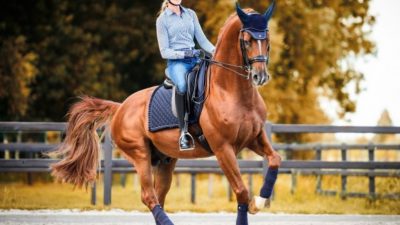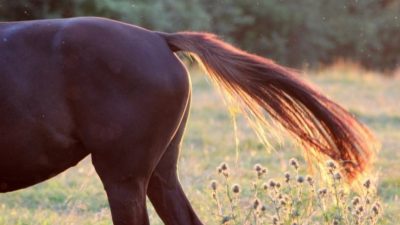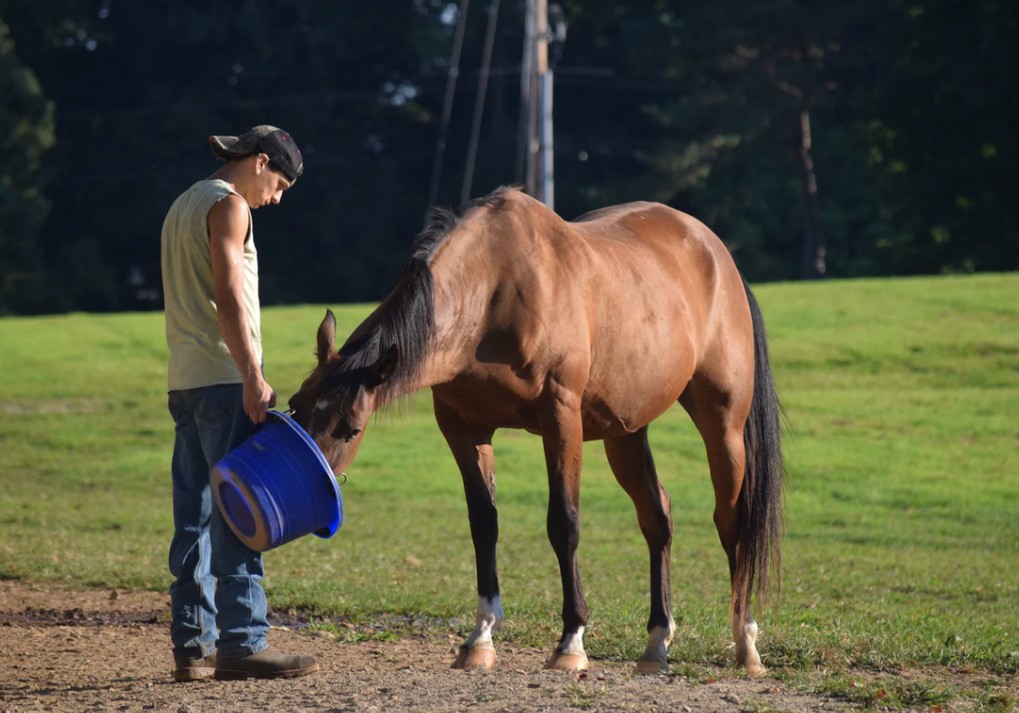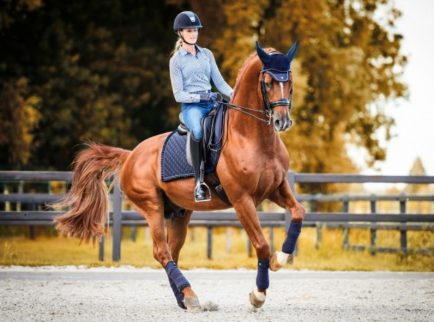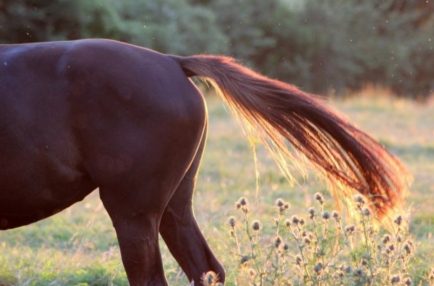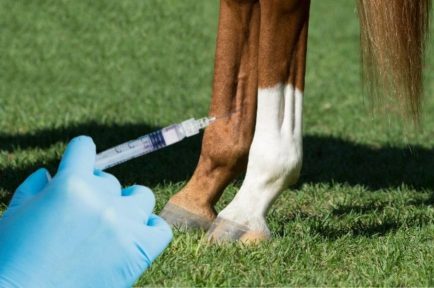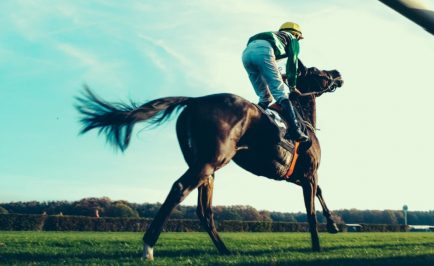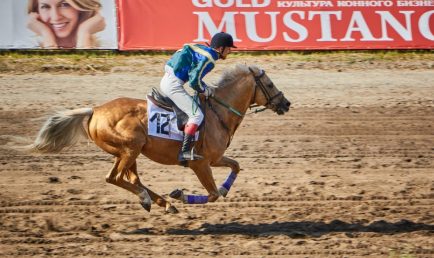Overlooking subtle change is easier than it should be. When you care for your horse every day, you may not notice slight variations in his body condition. Then one morning it strikes you: Watching him turn toward you in the paddock, you can see a faint outline of every rib along his sides, and his haunches are looking a little less rounded, too. Clearly, your horse is losing weight. And suddenly the questions are flying through your mind: What’s wrong? Is he sick? Am I not feeding him right?
Take heart. Many thin horses are suffering from nothing more than “agroceroisis—a lack of groceries!” says equine nutritionist Sarah Ralston, VMD, PhD, DACVN, of Rutgers University in New Jersey. In other words, a horse loses weight simply because his caloric needs are not being met. Either he’s burning more energy than he’s consuming, or somehow he is not utilizing the feed that he does eat efficiently enough.
The next question, then, is Why? A number of underlying issues can cause weight loss in a horse, and to help him regain some pounds, you first need to understand and address what’s going wrong. Only then can you develop a plan to restore him to his proper weight.
Why Horses Lose Weight
A number of factors, mental and physical, can cause a horse to lose weight, and in fact, his difficulties may stem from multiple problems. Of course, some horses seem naturally more prone to weight loss; a “hard keeper” may have a metabolism that requires more than the usual amount of calories for maintenance, or he may readily lose his appetite—and drop pounds—in response to even slight variations in management routine, weather or other factors. Likewise, a horse who is stressed by travel, intense training, herd squabbles or other disruptions may eat less and/or burn more energy and end up losing weight. But if your otherwise robust horse suddenly loses weight without apparent reason, ask your veterinarian to help you investigate the causes. Here are some of the possibilities:
• Illness. A number of diseases can lead to weight loss. Most will be accompanied by other obvious signs, such as diarrhea, colic, fever or lethargy—but in some cases signs of illness might be extremely subtle or nonexistent. “If your horse starts losing weight and his diet has not changed, get the veterinarian out ASAP,” says Ralston. “Check his liver and kidney function and screen for chronic infections.”
During the examination, your vet-erinarian may also suggest a fecal egg count and discuss your deworming schedule. A heavy parasite load can not only rob your horse of calories but also over time it may damage his intestinal tract to the point that it inhibits his ability to extract nutrients from his food.
Your veterinarian will also investigate possible sources of chronic pain, which can put a horse off of his feed. In fact, weight loss is one of the major signs of gastric ulcers, along with tooth grinding, a grumpy attitude and poor performance. Treating any underlying illnesses or injuries will likely be enough to get him gaining weight again.
In addition, the pain of arthritis can interfere with a horse’s feed intake by preventing him from walking to hay feeders or covering enough ground to graze sufficiently. Adding feed stations in strategic spots in larger pastures may make them easier to reach, and horses with pain in the neck or withers will graze more comfortably from a net or rack at shoulder height.
• Dental issues. Problems with a horse’s teeth can affect his ability to eat: Uneven wear can cause hooks, waves and other malformations that inhibit chewing, and cracked, broken or infected teeth can be painful enough to prevent a horse from chewing his food properly. In addition to weight loss, signs that a horse is experiencing dental problems might include dropping partially chewed feeds from the mouth, bad breath, fussiness with the bit and unchewed grains and bits of hay in the manure.
Routine dental exams—annually for most adult horses, or every six months for seniors or those who have had problems in the past—can catch and address any developing problems early, before they affect a horse’s over- all health and body weight. By the time he reaches his late 20s or 30s, a horse’s teeth may wear down completely so that he cannot properly chew coarse feeds or hay. At this point, he’ll need softer foods, such as soaked hay pellets, beet pulp or senior feed, to maintain his weight.
• Social problems. Horses who live in stable herds develop distinct social hierarchies, and those at the bottom of the pecking order—often the very young, the aging or the submissive—may be chased away from the hay feeder and other sources of food. One solution is to bring the low-ranking horse in to a small paddock or stall where he can eat undisturbed. Another option for horses in turnout is to distribute hay around to multiple feeders, or to use one that the horses can access from all sides without getting trapped against a fence, so that everyone gets access to a share.
Don’t forget that a horse’s social status can change over time, and the addition or subtraction of other members can rewrite the whole equation. Keep tabs on conditions in the field to make sure none of the horses are being bullied away from the food or water.
• Personality. We all know them—those busybodies who spend their time running back and forth between window and door, nickering to other horses and soliciting attention from every person. These social butterflies may have a hard time focusing on their meals. It might be best to move them to a quieter location, or offer them their larger meals at night when the barn is more peaceful, so that they can settle down and give their full attention to eating.
Then there’s the picky eater, who pushes his pellets around or picks out the choicest bits of hay and poops on the rest. If this is your horse, you may have to get creative, experimenting with different types of forage or changing its form. Some horses who pick through hay will readily eat pellets or cubes. And sometimes the horse who walks away from an overflowing manger will eat the same quantity if it’s divided up into six smaller meals per day. Slow feeders—hay nets or other devices with small openings that allow a horse to draw out only small amounts of hay at a time—can keep a horse interested in “grazing” longer, with less waste.
• Environmental conditions. Horses burn more calories to stay warm in cold weather, but extreme heat can also cause them to lose interest in food.
In the winter, steps to help a horse who is having trouble keeping on weight include adding blankets and bringing him into the barn when temperatures dip. Make sure pastured horses have access to shelter that will shield them from prevailing winds. Free-choice access to hay will also help a horse to generate internal heat around the clock. Slow feeders can keep the hay clean while helping the ration last longer.
On the hottest summer days, bringing horses into a cool, well-ventilated barn with fans can help them cope with the heat, and deep, shady shelters are essential in turnouts—to provide protection from the sun as well as from biting flies. Horses can expend huge amounts of energy stomping, shaking and running away from pests like horseflies. If biting flies are a problem in your area, protecting your horse with fly sheets, sprays, traps and other measures can help him to focus more on grazing.
Ample fresh water, of course, is essential year-round—loss of appetite is one of the effects of dehydration. Installing heaters or taking other steps to prevent water buckets from freezing in winter is crucial, and in the summer moving some of the outside sources into the shade can help to keep it more palatable. Soaking a horse’s feed can sometimes encourage him to eat more, but never provide more in one meal than he can eat before it either freezes in winter or goes rancid in the summer heat.
Getting Started
Once you’ve identified and addressed the most probable reasons for your horse’s weight loss, it’s time to develop a strategy to put the pounds back on. If you’re faced with an extremely thin horse—one whose vertebrae, ribs, and other bones are prominent—call in veterinary help right away. Introducing starving horses to too much food too quickly can cause serious digestive consequences that may be fatal. However, if your horse is only moderately thin, you can probably handle managing his weight gain yourself—just be prepared to call your veterinarian if have any questions or run into difficulties.
First, it’s a good idea to establish a system for measuring your horse’s weight as accurately and objectively as you can. You have several options (see “Two Ways to ‘Weigh’ a Horse,” page 32). Whichever method you choose, record your measurements in a journal, starting with a baseline, to keep track of subtle changes over time. Photographs, taken in good light while your horse is standing on level ground, can be a good supplement to your records. Just don’t rely entirely on your eyes and memory—you may have difficulty recalling details if you need to explain anything to your veterinarian later.
Also establish a good baseline measurement, in pounds, of what your horse currently eats. If you don’t have one already, buy a food scale and weigh out your horse’s normal ration. Even flakes of hay can vary in weight, and if you’re measuring out feed by volume—in a coffee can, for instance—you may discover that you’re feeding substantially less than a manufacturer’s recommended portion, which is usually given by weight. But it’s important to know how much your horse eats up front so that you can begin increasing his feed in an orderly fashion.
If your horse has been inactive, consider implementing a moderate exercise program. It may seem counterintuitive to make a thin horse burn calories to gain weight, but the work will help him to build muscles, and exercise will increase his appetite.
As you develop your plan, keep one rule in mind: Go slowly. All changes to a horse’s diet need to be made gradually. Your horse didn’t become skinny overnight, and he can’t safely gain weight in a hurry, either. Abrupt changes in a horse’s diet can lead to colic, laminitis and other ills.
First, the Forage
Before you go shopping for new products, the first step is to gradually increase a horse’s current feed, and of course, the cornerstone of the healthy equine diet is forage. In fact, the average pleasure horse in light to moderate work can maintain a healthy weight on forage alone.
To sustain a healthy weight, a horse needs to consume a daily ration of 2 to 3 percent of his body weight each day; of that, at least 1.5 to 2 percent needs to be some form of forage. That means two pounds of total feed for every 100 pounds that he weighs, or 20 pounds for a 1,000-pound horse just for maintenance—more will be needed for weight gain.
To help your horse gain weight, assuming he was getting restricted amounts of good-quality hay, Ralston suggests increasing his current forage ration until his total feed reaches at least 2.5 percent of his desired body weight. In other words, if your horse currently weighs 1,000 pounds, and you’d like him to be 1,100, then your target would be 2.5 percent of 1,100, or 27.5 pounds of hay.
The quality of the forage matters, too. If your hay and pasture are poor, then your horse is filling his gut with fiber but not getting adequate calories or nutrients. An extension agent can help you assess the nutritional value of your pasture and hay. Since few areas of the country allow for high-quality grazing year-round, most of us must supplement our horses’ diets at least part of the time with hay.
You want to choose the highest quality hay you can find for your thin horse. That means leafy, green hay with a minimum of brown stalks and mature seed heads. One quick test of the quality of hay is to squeeze a handful. Stiff stalks that hurt your palm are not a good choice when you need a higher calorie feed. If you want a more scientific analysis of your hay, you can send a sample off to a laboratory to have the nutritional value assessed.
Blending a flake or two of good-quality alfalfa in with a ration of grass hay is another way to add nutritional value to your forage. Alfalfa is higher in calories and protein than grass hays, which makes it an excellent choice to help to add weight to a thin horse. If your horse tends to be wasteful with his hay, he may eat more when offered alfalfa hay cubes or pellets.
Another fiber supplement is beet pulp, which contains about the same digestible energy as good quality hay. Most horses seem to like beet pulp, and it’s a good matrix for blending in supplements or other feed additives such as oils or rice bran. Introduce it slowly, one pound (dry weight) per feeding, up to 0.5 percent of your horse’s body weight. Although beet pulp is a good source of calories, it is not a complete protein source, and it’s relatively low in vitamins and most minerals, so it works best as an addition to, not a substitute for, your horse’s regular rations.
Fats, for Calories
Forage may be the cornerstone of equine nutrition, but it’s not a calorie-dense food, and there’s a limit to how much a horse will eat in a day. If your horse has been consuming all of the forage he wants, and he still is not gaining weight after several weeks, it’s time to add some more calories to the ration.
The safest way to increase the energy in your horse’s ration is to bolster the fat content. While carbohydrates and proteins offer around four calories per gram, fats offer a whopping nine calories per gram. If introduced slowly, horses can adapt to higher fat intakes, and you can reduce the concerns associated with really high starch intakes such as wide fluctuation in blood glucose and insulin levels seen with high-grain concentrates.
You’ll find a number of supplements and feeds on the market formulated to help horses gain weight safely. Most contain high amounts of fat as well as amino acids, vitamins, minerals and other nutrients that help a horse build and maintain muscle. Some of these products can be pricey, however, especially if your hard-working hard-keeper needs to stay on them long-term to keep his weight up.
One of the simplest and cheapest ways to add fat to your horse’s diet is vegetable oil from the grocery store, which can be poured over his regular concentrate ration. Corn oil is palatable to most horses, but you can also use canola, peanut or any other vegetable oil your horse likes. Although you’ll hear debate about the ideal ratios of omega-3 to omega-6 fatty acids in all of these products, when you’re trying to put weight on a horse, all fats are good fats. Like with other dietary changes, oil needs to be introduced slowly, starting with a quarter cup per day, and adding another quarter cup every few days, up to a maximum of two cups for an average size horse—less for small horses and ponies. Too much too fast, and your horse will develop diarrhea and steatorrhea (fatty stools)—his manure will have an oily sheen from undigested oils passing through his system. Another problem with oils is they can go rancid, so be sure to store the bottle in a cool place and give it a sniff before feeding.
Rice bran is another source of fat that most horses love, and it’s also rich in vitamin E as well as fiber. The biggest concern with rice bran is that it is also high in phosphorus, which can inhibit the amount of calcium available in the horse’s body. If you’re feeding a natural rice bran, you might want to add a calcium supplement or another calcium-rich food, such as alfalfa. To be safe, consider purchasing a rice bran product formulated for horses that contains added calcium to balance the ratio of the two minerals.
As with oil, rice bran needs to be added to the diet slowly, starting with about a cup at a time, working up to one or two pounds daily. Follow feeding instructions on the label for serving sizes for any commercial products.
Finally, Concentrates
Grains, sweet feeds and other starch- and sugar-based concentrates had long been the high-calorie foods of choice for thin horses, especially those in hard work. They are convenient to use, but the benefits come with a price: Feeds that are high in starch and sugar can pose some health risks if fed in large amounts. When a horse eats more starch in one meal than he can break down in his stomach and small intestine, the undigested molecules ferment in the hindgut, which increases the acidity and throws the microbial population out of balance—not only may the horse’s gut become less efficient at digesting fiber, the resulting changes can lead to colic and crippling acute laminitis. Although some horses seem to be more sensitive to starches than others, says Ralston, “You can induce laminitis in any horse with a sudden grain/starch overload.”
Commercial concentrates, which are formulated for complete, balanced nutrition, can be a valuable source of calories for a thin horse, but they must be used wisely. First, select a product that is formulated for your horse’s stage of life and activity level. Then, follow the instructions on the label to introduce the feed slowly and carefully to his diet.
Never feed more than 0.5 percent of a horse’s body weight of concentrates in a single meal, says Ralston. That’s five pounds for a 1,000-pound horse. If your hard-keeper or athlete needs more than that to gain weight, break his portion up into as many small meals as you can manage, spread throughout the day.
No matter what type of concentrates and added fats you incorporate into your horse’s diet, remember to make sure he always gets at least 1.5, preferably 2, percent of his body weight in forage each day. He needs it to keep his gut functioning at its best.
The basic concept behind fattening up a thin horse is fairly simple: Feed him more calories. But the devil is in the details. It may take some trial and error to find the right combination of forages, fats and concentrates to keep your horse healthy and strong. If you have trouble bringing your horse back to his ideal weight, don’t hesitate to consult with an equine nutritionist. Keeping weight on a perpetually thin horse can be tricky, but the effort will be worth it when you see him moving out across the pasture looking fit, strong and healthy.
Original article: Feeding for weight gain (dressagetoday.com)
Royal Equestrian – Riding Apparel, Horse Fashion, Horse Tack (royalequestriancollection.com) – check our website to purchase and enjoy our products for your horses and you.









